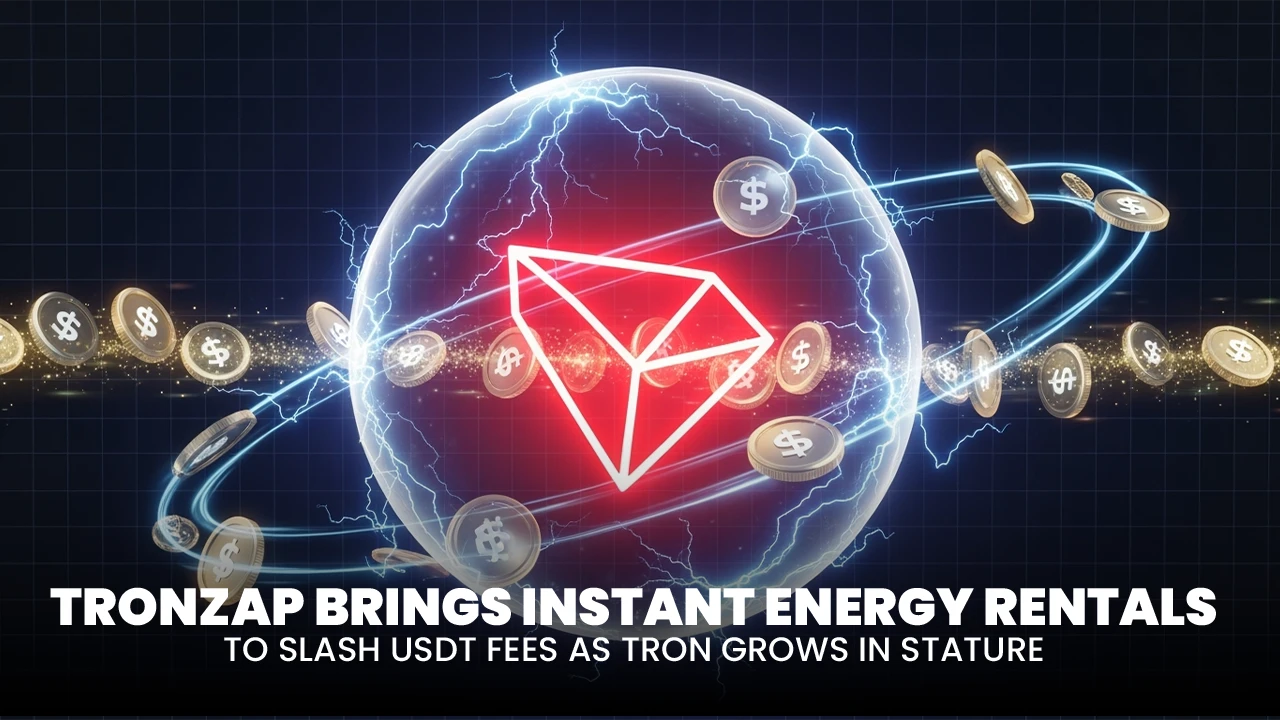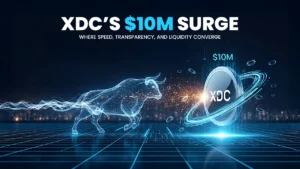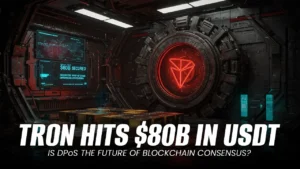TronZap Brings Instant Energy Rentals to Slash USDT Fees as TRON Grows in Stature

The TRON blockchain has never been a stranger to bold innovation, but its latest development could mark a turning point in how stablecoin transactions are handled at scale. TronZap, a fast-growing infrastructure player in the TRON ecosystem, has introduced instant energy rentals, a feature designed to reduce USDT transfer fees and make transactions significantly cheaper for both everyday users and institutions.
- TRON Price Rally and Network Momentum
- Cutting Transaction Costs with Instant Energy Rentals
- Delegated Proof of Stake Underpins the System
- Adoption Metrics and Ecosystem Impact
- Institutional Capital and Strategic Positioning
- Smooth Transitions and Synthesis
- Conclusion
- Frequently Asked Questions (FAQs)
- Glossary of Key Terms
At first glance, this may sound like another incremental improvement in blockchain mechanics. In reality, it’s much bigger than that. Stablecoins are the lifeblood of crypto commerce, and TRON has quietly become their undisputed home. With more than $77.7 billion in USDT hosted on its network, TRON now processes more stablecoin activity than even Ethereum. Every fee reduction, every boost in efficiency, directly amplifies that dominance.
TRON Price Rally and Network Momentum
The launch of TronZap’s instant energy rentals arrives at a time when TRX itself is rallying. Over the past month, the token has surged nearly 18 percent, fueled by record-breaking network activity, institutional support, and a staggering $343 million in monthly protocol revenue. Behind the charts, the TRON ecosystem is showing both financial muscle and real-world adoption: over 8.29 million weekly USDT transactions, remittance flows, e-commerce payments, and even gig-economy use cases like freelancer settlements.
But the brilliance of TronZap’s model lies in its simplicity. By allowing users to rent energy instead of burning TRX, the service cuts transfer costs by nearly fourfold—from about 13.4 TRX per transfer down to 3.7 TRX. It’s fully non-custodial, requires no logins, and delivers energy to any wallet in under a minute. For users juggling dozens of transactions a day, whether they’re DeFi traders, gamers, or merchants, that’s game-changing.
Underpinning all this is Delegated Proof of Stake (DPoS), TRON’s consensus mechanism. Unlike Proof of Work chains, where mining drains power, DPoS ensures fast, low-cost validation by letting token holders elect delegates. TronZap builds on that foundation by aggregating staked TRX and distributing energy on demand. The result is a blockchain that isn’t just fast, it’s adaptable, cost-efficient, and primed for mainstream adoption.
This development also comes at a moment of high visibility for TRON as an institution. A recent SEC-approved $1 billion shelf offering, a Nasdaq opening bell celebration, and hundreds of millions in strategic investments have all underscored TRON’s ambitions beyond crypto circles. Pair those moves with user-level improvements like TronZap, and you get a story of top-down and bottom-up momentum converging into one of the strongest growth narratives in blockchain today.
TronZap’s launch may look like a technical tweak, but its ripple effects stretch far wider: reducing friction, boosting adoption, and solidifying TRON’s status as the blockchain of choice for stablecoin transactions worldwide.
Between technical strength in the charts, overbought RSI, and price holding above the 30‑period EMA, and truly massive usage, TRON’s momentum is clear. The network is processing over 11.1 billion transactions, confirming continued buyer dominance in the market.
Revenue performance also commands attention. In May 2025 alone, TRON posted a staggering $343 million in protocol fees, a new monthly record. At the same time, USDT activity on the network exceeded $23.4 billion in daily volume, and the network holds $77.7 billion in USDT, surpassing Ethereum for the first time.
Institutional and real-world adoption is clearly rising. Weekly USDT transactions topped 8.29 million in early August, with mid-sized transfers ($101–$1,000) prominently featured, suggesting use cases like freelancer payments, e-commerce, and remittances.
Meanwhile, engagement shows no signs of slowing. On August 12, TRX rose again by about 1.87 percent as transaction volume hit new highs and staking activity picked up significantly, hinting at growing commitment from holders.
Cutting Transaction Costs with Instant Energy Rentals
High-speed, low-cost transactions are the backbone of TRON’s growing user base. The key resource? TRON energy. Without it, USDT TRC‑20 transfers are deducted from a user’s balance, burning up to 13.4 TRX per transfer.
TronZap now offers instant access to energy rentals, fully non-custodial, no-login, and delivered in under 60 seconds via its website or Telegram bot.
This enables users of any wallet (TronLink, Trust Wallet, TokenPocket, etc.) to avoid burning TRX. Energy rentals cut USDT transfer costs to as little as 3.7 TRX, representing nearly a 4x reduction in fees.
This is a straightforward PEE structure:
- Point: TronZap enables low-cost, instant USDT transfers.
- Evidence: Users pay 3.7 TRX vs. the 13.4 TRX burn rate without energy.
- Explanation: By renting energy rather than burning TRX, users maintain liquidity and avoid wasted tokens.
On-chain, TronZap improves access and user experience, particularly valuable for DeFi users, on-chain gamers, or frequent traders who prioritize speed and low friction.
Delegated Proof of Stake Underpins the System
TRON operates under a Delegated Proof of Stake (DPoS) consensus model. This structure uses stakeholders to secure the network and delegate energy through tools like TronZap, enhancing scalability and cost efficiency.
Institutions benefit from DPoS’s low-latency confirmations and reduced cost overhead, which drives TRON’s stablecoin dominance.
TronZap’s model leverages DPoS infrastructure by aggregating staked TRX to provide energy rentals and enabling both individual users and dApp developers to access resources seamlessly.
The interplay of DPoS and instant energy supply is key to enabling mass adoption of low-cost, high-speed transfers on TRON.
Adoption Metrics and Ecosystem Impact
| Metric | Value |
| TRX Monthly Price Gain | ~18 percent |
| Network Transactions | ≈ 11.1 billion processed |
| Protocol Revenue (May) | $343 million |
| Daily USDT Volume on TRON | $23.4 billion |
| Total USDT Holdings | $77.7 billion (surpasses Ethereum) |
| Weekly USDT Transfers | 8.29 million transactions |
| Energy Rental Cost | ~3.7 TRX per USDT transfer |
| Standard TRX Burn Rate | 13.4 TRX per transfer |
These figures reveal strong institutional and retail momentum, underpinned by DPoS efficiency and improved cost-per-transaction via energy rentals.
Institutional Capital and Strategic Positioning
TRON Inc. has strengthened its institutional position by securing SEC approval for a $1 billion hybrid shelf offering, allowing for flexible capital raises for infrastructure, entertainment ventures, and TRX buybacks. That announcement coincided with an 18 percent instant price bump.
Additionally, TRON’s corporate restructuring, including a Nasdaq opening bell event and substantial equity injections (~$100 million equity and $210 million in strategic investments), has solidified its credibility with mainstream investors.
Smooth Transitions and Synthesis
From macro performance to user-level incentives, TRON’s trajectory is clear. Institutional tools like the SEC-approved shelf offering and Nasdaq exposure bolster credibility. DPoS enables efficient scaling.
Meanwhile, TronZap’s instant energy rentals cut friction for users, driving volume and fee revenue. The system creates a virtuous circle: low-cost execution boosts usage, which in turn drives token demand and network revenue, supporting further investment and adoption.
Conclusion
TronZap’s launch of instant, non-custodial energy rentals has transformed USDT transfer economics on TRON, reducing fees by up to 4x and enhancing usability.
This advancement comes as TRX rallies on robust on-chain activity, institutional backing, and strong protocol revenue. With Delegated Proof of Stake powering efficient resource allocation, TRON is becoming the go-to blockchain for stablecoins, with accessible, high-speed infrastructure attracting both institutional and retail users.
Frequently Asked Questions (FAQs)
Q1: How much does a USDT transfer cost with TronZap energy?
A1: Approximately 3.7 TRX per transfer, compared to 13.4 TRX burned without energy.
Q2: How fast is the energy rental process?
A2: Energy is delegated within 60 seconds via TronZap’s website or Telegram bot.
Q3: Does TronZap require wallet credentials?
A3: No. TronZap is fully non-custodial; users keep their private keys.
Q4: What enables TRON’s high transaction throughput?
A4: Delegated Proof of Stake (DPoS) ensures fast block creation and efficient resource use.
Q5: How does TRON compare to Ethereum in stablecoin usage?
A5: TRON surpasses Ethereum in both total USDT holdings and daily stablecoin transaction volume.
Glossary of Key Terms
- Delegated Proof of Stake (DPoS) – A consensus mechanism where stakeholders elect delegates to produce blocks and secure the network efficiently.
- TRON Energy – A computation resource required for smart contract interactions and USDT transfers on the TRON network.
- USDT TRC-20 – Tether stablecoin token standard issued on the TRON blockchain.
- Non-custodial – Services where users retain control of their private keys and wallets; there is no intermediary custody of tokens.
- Hybrid Shelf Offering – A flexible way for public companies to raise funds via a range of securities (stock, debt, etc.) under a single SEC-approved filing.
- RSI (Relative Strength Index) – A momentum indicator used in technical analysis to measure overbought or oversold conditions.




